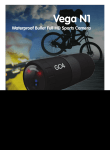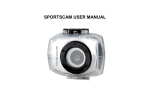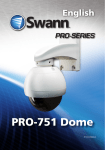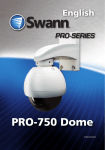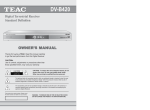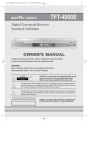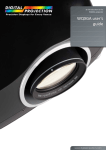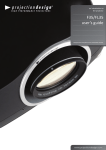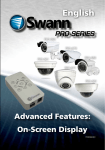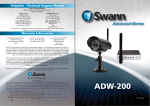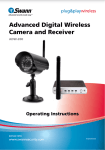Download Swann SWVID-SPORTW
Transcript
English Bolt HD M690CAM080911E 1 (Important) Legal Mumbo Jumbo FCC Verification: NOTE: This equipment has been tested and found to comply with the limits for Class B digital device, pursuant to part 15 of the FCC Rules. These limits are designed to provide reasonable protection against harmful interference in a residential installation. This equipment generates, uses and can radiate radio frequency energy and, if not installed and used in accordance with the instructions, may cause harmful interference to radio or television reception, which can be determined by turning the equipment off and on, the user is encouraged to try to correct the interference by one or more of the following measures: • Reorient or relocate the receiving antenna • Increase the separation between the equipment and the receiver • Connect the equipment into an outlet on a circuit different from that to which the receiver is connected • Consult the dealer or an experienced radio/TV technician for help IMPORTANT NOTE: Prohibition against eavesdropping Except for the operations of law enforcement officers conducted under lawful authority, no person shall use, either directly or indirectly, a device operated pursuant to the provisions of this Part for the purpose of overhearing or recording the private conversations of others unless such use is authorized by all of the parties engaging in the conversation. WARNING: Modifications not approved by the party responsible for compliance could void user’s authority to operate the equipment. 2 Contents (Important) Legal Mumbo Jumbo 2 Contents3 Introduction4 Where Stuff is At (The Layout) 5 Getting Started6 Your microSD Card and You8 You Got the Power: Charging the Battery 9 The Button: a.k.a. “Operating Guide” 10 Resolution: Choosing It11 Seeing how cool you are (Playback) 12 Playback on a Computer13 HDMI & Composite Video Playback 14 The Remote Control15 Options, Options: The Onscreen Menus 16 Showing your Quality18 Mounting the Camera19 Shooting Your Troubles21 Technically Speaking (Specifications) 22 Warranty / HelpdeskRear Cover 3 Introduction You’ve gone and done it now. Really taken the cake. You’ve bought a Bolt HD 1080p Waterproof SportsCam - the miniature, waterproof, easy to use, full HD personal action video recorder from Swann. Kudos to you! Can’t say we’re not envious. You’ve nabbed yourself a camera that’s perfect for capturing your insane antics and displays of immense skill*. It’s great for recording biking, skating, skiing or snowboarding, surfing or throwing yourself out of a perfectly good aircraft. Or just about anything else you can think of! Strap it to your head, arms, legs, butt, bike, board, gear, rigging or shoes. Or you can think outside the box. Use it to capture video to show your friends and share your videos online. Don’t talk big. Show big. Prove you did it with the SportsCam. * The camera isn’t going to make you any more skilled. Sorry. It ain’t magic, just miniaturized technology. You’ll have to provide the skill! 4 Where Stuff is At (The Layout) Power / Record Button Heck, we might as well call it “the button” - it is all on its lonesome. Targeting Laser Lasers make everything cooler. Lens A bit of high-quality glass used to focus stuff. The Backside Reset Sets everything back to the factory defaults. The Frontside Rear Cap Indicator LED The SportsCam can’t talk, so it flashes a little light to let you know what it’s up to, like Captain Pike from that old episode of Star Trek. USB Port For charging, computers and composite video output. 1080p / 720p Switch Choose between 720p (nice) and 1080p (seriously nice). microSD Card Slot For inserting a microSD card and nothing else. Mini-HDMI Port Pure awesomeness in one output. Infrared Sensor (for Remote) We tried a brainwave sensor here, but it turns out they still only work in science fiction. So, the IR sensor works like the one in your TV. You’ll need the rear cap off to use the remote. 5 Getting Started Right. So: you’ve got the SportsCam. It’s Friday afternoon, and you’re headed out skating on Saturday morning and you want to get the SportsCam setup and ready to rock and/or roll. 1. Charge the battery. Short version: Plug the little end of the USB cable into the SportsCam, and the big end into the included power adapter. Plug the power adapter into a wall socket. Wait two to three hours. Bam! Check out page 9 for the long version on getting yourself some power. 2. Jam a microSD card in it. Gently. Short version: Ensure there’s nothing on the microSD card you want to keep, as we’ll be formatting it in a moment (that erases all the data and preps it for recording video). The SportsCam shoots high-def video, so grab yourself a decently big card - we reckon that 8GB is a realistic minimum, with 16GB or 32GB cards recommended. Check out page 8 for the long version regarding microSD cards. 3. Set up your Camera using the On-Screen Menus Short version: Connect the SportsCam to a television or monitor using either the mini-HDMI output or the COMPOSITE VIDEO output (that’s the weird USB to RCA cable - one end goes into the USB port on the SportsCam and the other to the VIDEO IN on a TV). Use the Remote Control to access the menus see (“The Remote Control” on page 15). We think the best course of action is to: • Choose your recording format (PAL or NTSC). • Format your microSD card. • Set the Date and Time. • Choose your Resolution (see page 11). • Choose your Quality settings (check out page 18). 6 A few things you really have to get right: PAL or NTSC The Record Mode setting must be set correctly for your location if you want the highest quality playback possible. This setting is doubly important if you’re planning to shoot under or around fluorescent lights - if this is wrong, then they’ll ‘flicker’. Choose NTSC if you’re in the USA, Canada, Mexico, Korea or Japan. Choose PAL if you’re in the UK, Europe, Africa, or Australia. Format To clean old data off the microSD card and get it ready to record video, we suggest formatting it in the SportsCam. Date and Time The time is represented in standard US format: MM/DD/YYYY We suggest getting this right before you head out the first time. Unless you do a complete reset of the unit or completely drain the battery (it will automatically shut down before this happens) you shouldn’t have to set it again. 7 Your microSD Card and You Choosing a microSD card: The SportsCam will accept a microSD card up to 32GB in capacity. You can store between 7 ~ 30 minutes worth of video per gigabyte (GB). Check out page 18 for more information on recording times versus quality settings. We recommend using cards of at least 8GB to ensure that the SportsCam won’t run out of storage space whilst you’re filming, 16GB or 32GB are recommended for recording in 1080p at high quality. Of course, if you only want to record ten minutes at a time, you could get away with a much smaller card. But remember, when it runs out that’ll be all she wrote! For reliable performance, we strongly suggest that you use a card with a speed rating of “Class 4” or higher. Look for these symbols: 4 6 D D Inserting a microSD card: • Hold the SportsCam so that the rear panel is facing you, and the power/record button is facing up. • Orient the microSD card so that the text is facing up. • Gently push the microSD card into the slot. Be careful that it goes in correctly - if it misses the slot or is inserted at an angle, it could become jammed. • The card will “click” into place once fully inserted. • To remove the card, simply push it in. This will release the locking mechanism, and the card will spring out. Be careful when removing the microSD card - the little spring that pushes it out is quite powerful. 8 You Got the Power: Charging the Battery The SportsCam charges via the mini USB socket on the rear panel. • Insert the mini-USB plug on the USB adapter or USB cable into the USB socket on the rear of the SportsCam. • Connect one end of the USB adapter or cable to the USB port on the included power adapter. Under no circumstances ever connect the SportsCam to any power source supplying anything other than 5V. It’s safe to connect it to a USB port on a computer (see below!) and the included power adapter. Computers don’t cut it! The current supplied by most computer’s USB ports (5V 500mA) is not sufficient to properly charge the SportsCam. The SportsCam’s battery is small, but powerful, and it needs more juice to charge. The supplied adapter (5V 1000mA) is perfect for the job, and you’ll get much better results using that. Charging Status Indicator LEDs (a.k.a. “Them there glowin’ things!”) While the SportsCam is charging, the red LED on the rear panel will light up. It will go out when the SportsCam is fully charged. The green LED will light up whenever the SportsCam is connected to power. The LEDs As the green and red LEDs are located are here... very close to one another, you might right here. need to tilt the SportsCam slightly relative to your eye to see what both of them are doing! The SportsCam takes 2 hours to charge using the included USB charger. It will take much longer from a USB port, if it charges at all. 9 The Button: a.k.a. “Operating Guide” Button, button, who’s got the button? Oh, it’s where we left it, right in the middle on the top. Pretty obvious, really. Things that Pressing The Button will do Turning the Camera on and Recording Video While the camera is off, charged and disconnected from any USB or HDMI connection (PC, composite video, HDMI or charger) press and hold the button down for approximately 2 ~ 3 seconds. The camera will beep three times. The LED on the front of the camera will light up for a moment, and will flash red while recording video. The targeting laser will come on for a few seconds unless disabled, then automatically go out. Engage the Targeting Laser While the camera is on, press the button and hold for a quarter of a second and then release. The targeting laser will come on for a few seconds and then automatically switch off. Stop Recording and Shutdown Camera Booting the Camera into HDMI, USB or Composite Video Modes 10 While the camera is recording, press and hold the button for about three seconds. The camera will beep twice, and the green LED will light up for a moment. When the SportsCam is turned OFF, insert the cable associated with your desired outcome (USB cable for a computer, USB-to-RCA cable for Composite Video or the HDMI cable for HDMI). Connect the other end of the cable to the desired device (computer, monitor or TV, as applicable). Press and hold the button for three seconds to turn the camera on. The SportsCam will automatically boot into the appropriate mode for the cable connected. Resolution: Choosing It The SportsCam can record at two different resolutions: 720p (1280 x 720) and 1080p (1920 x 1080). To select your resolution, use the switch on the rear panel of the camera. 1280 720 1080 720p 1080p 1920 Why would you want to record at a lower resolution? Believe it or not, there are actually a few really good reasons to record at 720p. Here are a couple, presented in reverse order of pretentiousness: • It’s very, very slightly more retro, and (ergo) cooler. (Hipsters only.) • Not everyone can playback 1080p - many TV’s (even some marked “HD” can’t playback 1080p - most systems that can will claim “Full HD” or “1080p” somewhere on the unit or the packaging (most likely both). • If your TV supports 1080i but not 1080p (again, this will be written on it somewhere), then playback of 720p may actually have a slightly higher vertical resolution (720 lines versus 540) when displaying rapid motion. • 720p is often less prone to artefacting when recording rapid motion than 1080p. • 720p uses less space than 1080p - so, if you’re trying to get the most possible out of your memory card, then it’s a good option. 1080p requires approximately 8000 ~ 13000kbps, whereas 720p uses 4000 ~ 8000kbps (it varies by your Quality setting). You’ll get about 40 minutes of 1080p to the same space as 1 hour of 720p. 11 Seeing how cool you are (Playback) There are two ways to playback videos from the SportsCam, depending on your needs and access to equipment. The options are: Playback via a Computer Provided your computer meets the minimum specs to playback the SportsCam’s videos (most modern computers will). Playback via the mini-HDMI Port The mini-HDMI port on the camera is great connecting to a high definition television or monitor with HDMI inputs. Playback via the Composite Video Out The included USB to RCA cable can be used to connect the SportsCam to an old-school television with RCA inputs. These are often labeled as Video In, Composite In, AV, or similar. The composite video out puts out a standard definition signal (480 lines for NTSC, 576 lines for PAL) - so, there is a noticable drop in quality. Also, due to the analog nature of the technology, there’s the chance of some noise or distortion. However, it’s a great way to quickly review footage when you don’t have your full HD hundred-and-fifty inch plasma panel handy. File Type Information Container: MOV Compression: MPEG-4 AVC (Advanced Video Codec) Bitrate: 4000kbps (720p, low) to 12000kbps (1080p high) Audio Bitrate:128kbps Audio Channels: 2 (stereo) Sample Rate:48KHz 12 Playback on a Computer You can transfer data from the microSD card onto a computer for the highest quality playback possible. There are two options for downloading data to a computer: USB Cable Turn the SportsCam off. Connect the SportsCam to your computer using the USB cable. Press and hold the button for three seconds. The SportsCam will start up in USB storage mode. • The microSD card’s contents will be detected by the computer, and will be accessible in the same way as a USB flash drive. • Remember: the SportsCam will not charge while connected to a computer - it needs more juice! • • • • • Removing the microSD card Remove the rear cap of the SportsCam. Push the microSD card in to remove it. Be careful - the spring that pushes it out is pretty powerful. Use a USB card reader connected to your computer to access the files on the card. You may need an SD to microSD card converter, if your card reader doesn’t support the microSD format. Folder Format Removable Disk DCIM 100MEDIA MOVI001 101MEDIAMOVI002 102MEDIAMOVI003 ...etc...more files MISC (usually empty) 13 HDMI & Composite Video Playback You’ll need A HD-TV or high resolution monitor with HDMI IN and a mini-HDMI to HDMI cable. • • • • • • • • • • • 14 Remove the rear cap from the SportsCam. Connect an HDMI cable to the mini-HDMI output on the rear panel of the SportsCam. Connect the other end of the mini-HDMI cable to an HDMI input on your television/monitor. Set your television/monitor to the appropriate channel. Turn the SportsCam on (press and hold the button for about three seconds). Playback via Composite Video Out Remove the rear cap from the SportsCam. Connect the included USB to RCA cable to the mini-USB port on the rear panel of the SportsCam. Connect the Video Out plug (the yellow one) to a Video Input on your television, monitor or recording device (as applicable). It will most likely also be yellow. If you want to hear the action, connect the white (left) and red (right) plugs to your Audio Inputs. If your device is MONO, connect the white (left) one only. Set your television/monitor to the appropriate channel. Turn the SportsCam on (press and hold the button for about three seconds). The Remote Control Up / Volume + Power Off Menu Record Snapshot Mode Left / Rewind OK OSD (On Screen Display) DEL (Delete) Down / Volume - Right / Fast Forward STOP LOCK N/P (NTSC / PAL select) Laser On / Off Using the Remote Control during Playback • • • • Press MENU to open the on-screen menu. Press MODE to enter playback mode, and to switch from MOVIE to PHOTO playback mode. Use the arrow buttons to highlight the item you want to view, and press OK to initiate playback. Press STOP to end playback. 15 Options, Options: The Onscreen Menus System Configuration Menu TV Type PAL For connecting to and displaying images on a PAL television (for Europe, Australia, etc) NTSC For connecting to and displaying images on an NTSC television (USA, Canada, Japan, etc). Time and Set Date and Opens a sub-menu where you can easily set the date and time. The date is displayed as MM/DD/ Date Time Menu YYYY Time Stamp Power Off Laser The date will be displayed on recordings. The time will be displayed on recordings. Both the time and date will appear. Neither the time nor date will appear. 3 min The camera will automatically turn off after three minutes of inactivity. 5 min As above, but after five minutes. Off The SportsCam will stay on indefinitely until manually shut down. On The laser will automatically come on when the camera is turned on, and again when selected. Off English, Chinese The laser will not function. Default Yes, No Resets all options on the SportsCam to their factory defaults. Format Yes, No Formats the microSD card. Be sure you really want to do it - formatting deletes all data on the card. Firmware Version Displayed This is the version of the software running on the SportsCam. You might need to know this number if you call Swann tech support. Language 16 Date Time Date/ Time Off You can swap the language of the SportsCam between English and Chinese. Record Setup Menu Menu Item Quality Settings Description L (Low) The lowest data rate, approximately 4Mbps for 720p and 8Mbps for 1080p. This will maximize your recording time at the expense of quality. M (Medium) A middle-ground data rate, approximately 6Mbps for 720p and 10Mbps for 1080p. H (High) The best recording quality possible, approximately 8Mbps for 720p and 12Mbps for 1080p. This does require a lot of storage space. See page 18 for more detail on how the Quality setting affects recording time. Photo Size White Balance 3M 2048 x 1536 pixels / 1.5MB 4M 2592 x 1728 pixels / 2.1MB 5M 2592 x 1944 pixels / 2.6MB 8M 3200 x 2400 pixels /3.5MB 12M 4000 x 3000 pixels /4.8MB Auto The color balance is automatically adjusted by the camera. Incandescent For filming under artificial lights (tungsten bulbs and equivalent) and for light that appears slightly orange (approximately 3000°K) Sunny For shooting in natural daylight on a clear day. For “white light” (approximately 5600°K) Cloudy Suited to shooting on an overcast day, where the light appears slightly blue (approximately 6500°K) Fluorescent For shooting under artificial light from fluorescent lights, which are typically slightly green (approximately 4500°K) Water Record Mode For filming in water. NTSC Records at approximately 30 frames per second, for playback on NTSC systems. (USA, Japan) PAL Records at 25 frames per second, for playback on PAL systems (Australia, Europe) 17 Showing your Quality How much can I store on a microSD card? That depends on a few things. First, how big is your SD card? Secondly, what are you recording, and at what quality? The resolution and quality is going to have a huge impact on how much you’ll be able to record. Seriously - check it out: 720p 1080p Quality & Resolution Settings: Video Low Medium High 4007kbps 6270kbps 8334kbps (30 min per GB) (20 min per GB) (15 min per GB) 8109kbps 10284kbps 12361kbps (15 min per GB) (11 min per GB) (7 min per GB) Photo Quality 3M 4M 5M 8M 12M Dimensions 2048 x 1536 2592 x 1728 2592 x 1944 3200 x 2400 4000 x 3000 Size (approx) 1.5MB (600+ per GB) 2.1MB (475 per GB) 2.6MB (385 per GB) 3.5MB (285 per GB) 4.8MB (208 per GB) What happens when you lower the Quality? Basically, the camera tries to use less data to represent the same image. This means the compression needs to work harder. 720p @ LOW quality uses only half the data of 720p @ HIGH quality, and it looks about half as sharp. However, you’ll be able to store twice as much to your microSD card. It becomes more noticeable when you pause the video. Even at low quality, during real-time playback, the video still looks reasonable (and better than, say, most videos on YouTube or similar online video services). 18 Mounting the Camera Aiming the Camera: To figure out what the camera is looking at, we installed a neat targeting laser. We had to sacrifice our plans for the army of sharks with lasers on their heads to make this happen, so we hope you appreciate it. Basically, the little red dot will show you the center of the camera’s view. Additionally, it can be used as a neat tool to entertain cats. It will automatically turn on when you start recording with the SportsCam, and turn off automatically after a few seconds. If you want to turn it on again, press the button for approximately one second and release. Adhesive Fabric Straps There are two adhesive fabric strips included with the SportsCam. They have adhesive on one side and hook & loop fasteners on the other. You can stick these to any flat, non-porous surface, and use the hook & loop fastener to attach the camera. Some points to remember: • Carefully clean the area where you’re going to apply the strip. Ensure that it is completely free of moisture, oils, dust or any other contaminants. Cleaning alcohol or similar is recommended. • Carefully align the mounting strip. Once it’s stuck in place, that’s it. 19 Bar Mount • • • • The bar mount can be used to attach the camera to any bar or pole thin enough to fit into the mounting clasp. This is intended for mounting the camera to the handlebars of a bicycle or motorbike, but can be used to attach the camera to anything with the right shape (that is, round). Attaching the mount: Undo the screw holding the clasp shut. Apply the mount to the bar you’d like to attach thing to. Tighten the screw to secure the mount in place. The camera simply clips into position in the upper part of the mount. But you could figure that bit out, it’s kinda simple. Surf Board Mount The included surf board mount can be attached to any flat surface of sufficient size - typically a surfboard, but don’t let us limit you. • • • • 20 To apply the mount: Carefully clean the area where you’re going to apply the mount. Ensure that it is completely free of moisture, oils, dust or any other contaminants. Cleaning alcohol or similar is recommended. Carefully align the mounting plate. Once it’s stuck in place, that’s where it will be for a long time! Peel one side of the included adhesive pad, and apply to the underside of the mount. Carefully peel the other side of the adhesive pad and apply to the surface you want to mount to. Be careful that everything lines up! Shooting Your Troubles Q: It won’t turn on! A: Try turning it on and off again. Has the camera been left on/recording for a while for a while? Is the SportsCam charged? If not, check out “You Got the Power: Charging the Battery” on page 9. Also, don’t try to charge from a computer’s USB socket, because it probably won’t. Q: I can’t play back footage on my computer. A: Try using a different program, such as VLC Media Player (a favorite around the Swann office). It’s available free from www.videolan.org/vlc, and works with a huge range of operating systems. You may need to drag and drop the file onto the VLC (or appropriate program) window if the default file association isn’t right. Q: The audio sounds muffled. A: Are you using the waterproof cap? Unfortunately, sound doesn’t travel so well through solid plastic. That’s the downside about making it waterproof - it’s pretty soundproof, too. You can use this to your advantage - in many high wind situations (anything 65mph [100km/h] or faster) it can actually make the audio quality better. If you’re not using the SportsCam in or around water, try using the nonwaterproof cap (the one with the little holes). Sound travels better through holes (or so we’ve heard). Q: The audio sounds distorted/weird/too loud. A: This can often happen if you attach the SportsCam to a vehicle, skateboard, bicycle or anything else which vibrates when in use. Try it with and without the water-proof cap (unless you need it to be waterproof ). Try using a different mounting option. Try attaching the camera to your clothing using the hook & loop patches - cloth usually muffles vibrations and might improve the audio quality. Finally, remember that in certain situations you’re just not going to be able to get any decent audio - for example, when the background noise level is simply too high. It sucks but sometimes there’s nothing that can be done: physics is a harsh mistress. 21 Technically Speaking (Specifications) Sensor type CMOS 2592x1944 135 degrees @ 720p 110 degrees @ 1080p Viewing angle Storage consumption based on 2GB micro-SD (approx) Storage consumption based on 2GB micro-SD Snapshot 3M Snapshot 4M Snapshot 5M Snapshot 8M Snapshot 12M 1080p 720p Recording format Video Record Photo Resolution 22 1200+ (2048 x 1536) 950 (2592 x 1728) 770 (2592 x 1944) 570 (3200 x 2400) 416 (4000 x 3000) High: 15 min / Medium: 25 min / Low: 30 min High: 30 min / Medium: 40 min / Low: 60 min .MOV MPEG-4 AVC 1080p (1920x1080) @ 25fps (PAL) / 30fps (NTSC) Resolution 720p (1280x720) @ 25fps (PAL) / 30fps (NTSC) Snapshot 2048 x 1536 3M Snapshot 2592 x 1728 4M Snapshot 2592 x 1944 5M Snapshot 3200 x 2400 8M Snapshot 4000 x 3000 12M Digital Zoom AV AV output output HDMI USB Interface Charging Microphone Power Consumption Lithium Battery Record Time Laser power Storage temperature Operating temperate range Operating humidity range None Composite NTSC/PAL via USB to RCA cable mini-HDMI USB 2.0 for data transfer Included charger (5V, 1A) or via USB 2.0 Port 2 built in microphones (stereo) Approx. [email protected] (max.) 600mAh 90 min 1mW -4°F ~ 140°F / -20°C ~ 60°C -4°F ~ 122°F / -20°C ~ 50°C 15 ~ 85%RH Due to product improvements, specifications are subject to change without notice. For the latest version of this manual, visit: www.swann.com 23 Helpdesk / Technical Support Details Swann Technical Support All Countries E-mail: [email protected] Telephone Helpdesk USA toll free AUSTRALIA toll free 1-800-627-2799 1300 138 324 (Su, 2pm-10pm US PT) (M 9am-5pm AUS ET) (M-Th, 6am-10pm US PT) (Tu-F 1am-5pm AUS ET) (F 6am-2pm US PT) (Sa 1am-9am AUS ET) USA Exchange & Repairs NEW ZEALAND toll free 1-800-627-2799 (Option 1) 0800 479 266 (M-F, 9am-5pm US PT) UK 0203 027 0979 See http://www.worldtimeserver.com for information on time zones and the current time in Melbourne, Australia compared to your local time. Warranty Information Swann Communications USA Inc. 12636 Clark Street Santa Fe Springs CA 90670 USA Swann Communications Unit 13, 331 Ingles Street, Port Melbourne Vic 3207 Swann Communications LTD. Stag Gates House 63/64 The Avenue SO171XS United Kingdom Swann Communications warrants this product against defects in workmanship and material for a period of one (1) year from it’s original purchase date. You must present your receipt as proof of date of purchase for warranty validation. Any unit which proves defective during the stated period will be repaired without charge for parts or labour or replaced at the sole discretion of Swann. The end user is responsible for all freight charges incurred to send the product to Swann’s repair centres. The end user is responsible for all shipping costs incurred when shipping from and to any country other than the country of origin. The warranty does not cover any incidental, accidental or consequential damages arising from the use of or the inability to use this product. Any costs associated with the fitting or removal of this product by a tradesman or other person or any other costs associated with its use are the responsibility of the end user. This warranty applies to the original purchaser of the product only and is not transferable to any third party. Unauthorized end user or third party modifications to any component or evidence of misuse or abuse of the device will render all warranties void. For Australia: Our goods come with guarantees which cannot be excluded under Australian Consumer Law. You are entitled to a replacement or refund for a major failure and for compensation for any other reasonably foreseeable loss or damage. You are also entitled to have the goods repaired or replaced if the goods fail to be of acceptable quality and the failure does not amount to major failure. By law some countries do not allow limitations on certain exclusions in this warranty. Where applicable by local laws, regulations and legal rights will take precedence. © Swann Communications 2011 FCC Verification This equipment has been tested and found to comply with the limits for Class B digital device, pursuant to part 15 of the FCC Rules. These limits are designed to provide reasonable protection against harmful interference in a residential installation. This equipment generates, uses and can radiate radio frequency energy and, if not installed and used in accordance with the instructions, may cause harmful interference to radio or television reception, which can be determined by turning the equipment off and on, the user is encouraged to try to correct the interference by one or more of the following measures: • Reorient or relocate the receiving antenna • Increase the separation between the equipment and the receiver • Connect the equipment into an outlet on a circuit different from that to which the receiver is connected • Consult the dealer or an experienced radio/TV technician for help WARNING: Modifications not approved by the party responsible for compliance could void user’s authority to operate the equipment.
























